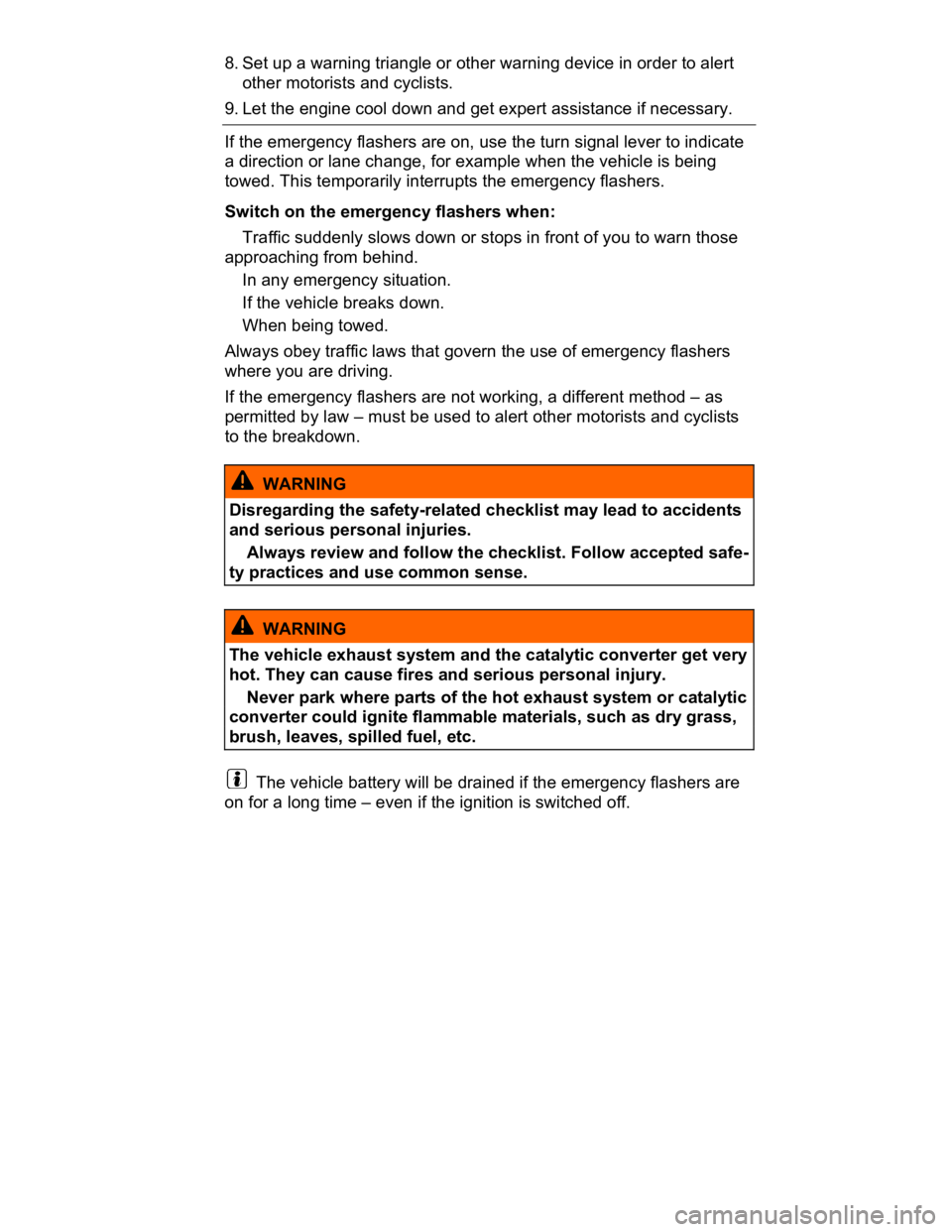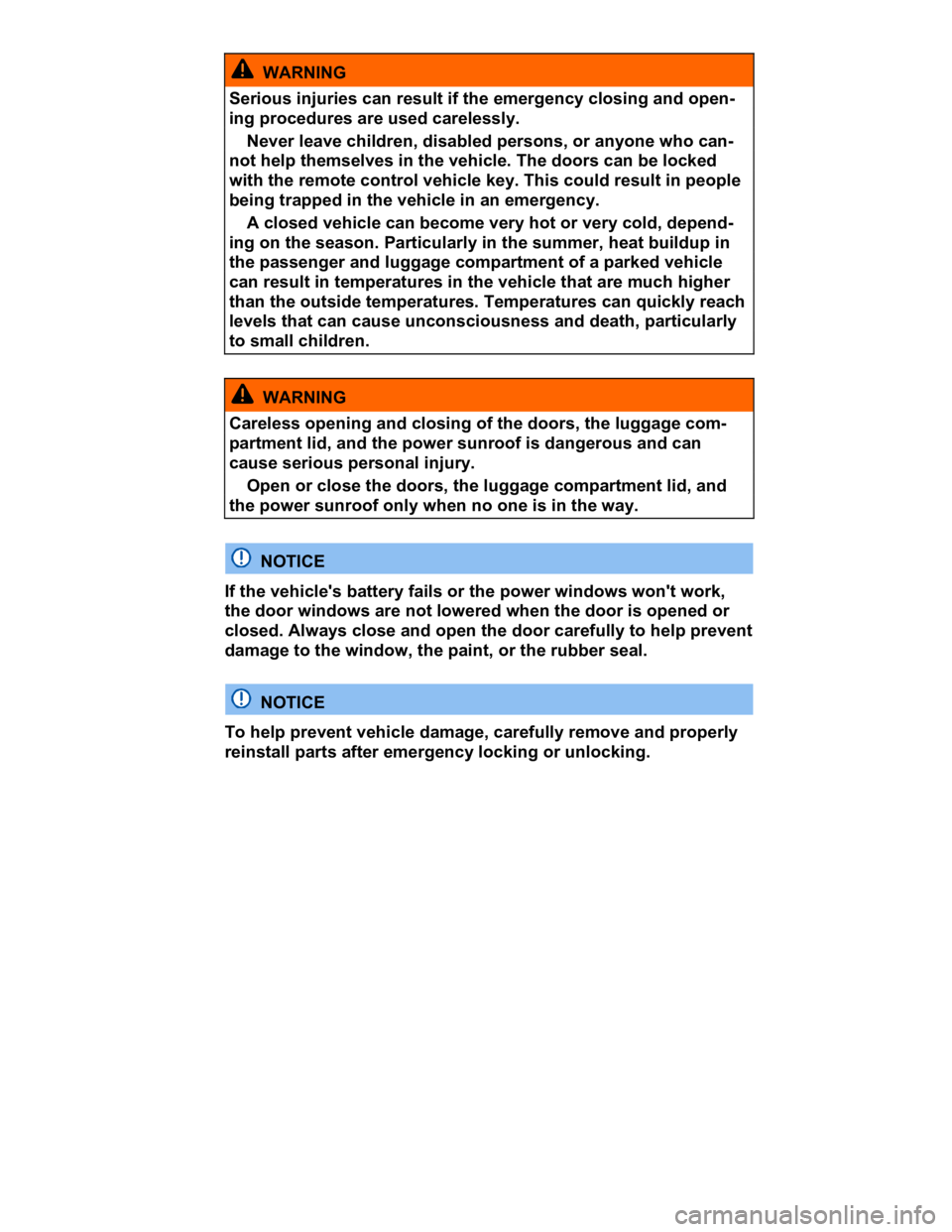Page 499 of 578

Description Possible causes,
among others Possible remedy
DSG® Direct Shift
Gearbox too hot.
Stop vehicle as soon as
you can safely do so.
Driver seat and
outside mirrors
move when vehi-
cle is unlocked.
Convenience
settings are stored.
Correct convenience
settings
Memory-seat set-
tings are stored.
– Reassign seat setting
– Clear memory-seat
memory
Front seats can-
not be adjusted
with power con-
trols.
Vehicle battery dead. Charge vehicle battery
Fuse blown. Check fuse and replace if
necessary
No jack, spare
wheel, or com-
pact spare wheel
in the vehicle.
Equipment differs
depending on the
vehicle.
No direct corrective action
possible; depends on the
vehicle equipment. Con-
tact an authorized
Volkswagen dealer or an
authorized Volkswagen
Service Facility for assis-
tance.
Vehicle has run-flat
tires (mobility tires).
Features do not
work as de-
scribed in this
manual.
Settings were ad-
justed in the
Volkswagen Infor-
mation System.
Check and reset to factory
settings if necessary
Headlights do not
light up the road
as they should.
– Headlights incor-
rectly adjusted.
– Light bulbs burned
out.
– Low beams not
switched on.
– Have the headlight
range adjusted by an au-
thorized Volkswagen
dealer or an authorized
Volkswagen Service Fa-
cility.
– Change light bulbs
– Switch on low beams
Page 500 of 578
Description Possible causes,
among others Possible remedy
Electrical con-
sumers do not
work.
Vehicle battery
charge too low. Charge vehicle battery
Remaining fuel level
too low. Refuel
Fuse blown. Check fuse and replace if
necessary
Fuel consumption
higher than indi-
cated.
– Short hauls.
– “Jumpy” accelera-
tor pedal.
– Avoid short distance
driving.
– Drive defensively.
– Accelerate smoothly.
Electrical loads
switched on.
Switch off unnecessary
loads.
Engine control
malfunction.
Have the malfunction cor-
rected
Tire pressure too
low. Adjust tire pressure
Driving in the
mountains.
No direct corrective action
possible.
Towing a trailer or
driving with a roof
rack.
– Check use.
– Remove if not in use.
Driving with heavy
payload.
No direct corrective action
possible.
Driving at high en-
gine speed. Select a higher gear.
Page 505 of 578

8. Set up a warning triangle or other warning device in order to alert
other motorists and cyclists.
9. Let the engine cool down and get expert assistance if necessary.
If the emergency flashers are on, use the turn signal lever to indicate
a direction or lane change, for example when the vehicle is being
towed. This temporarily interrupts the emergency flashers.
Switch on the emergency flashers when:
� Traffic suddenly slows down or stops in front of you to warn those
approaching from behind.
� In any emergency situation.
� If the vehicle breaks down.
� When being towed.
Always obey traffic laws that govern the use of emergency flashers
where you are driving.
If the emergency flashers are not working, a different method – as
permitted by law – must be used to alert other motorists and cyclists
to the breakdown.
WARNING
Disregarding the safety-related checklist may lead to accidents
and serious personal injuries.
� Always review and follow the checklist. Follow accepted safe-
ty practices and use common sense.
WARNING
The vehicle exhaust system and the catalytic converter get very
hot. They can cause fires and serious personal injury.
� Never park where parts of the hot exhaust system or catalytic
converter could ignite flammable materials, such as dry grass,
brush, leaves, spilled fuel, etc.
The vehicle battery will be drained if the emergency flashers are
on for a long time – even if the ignition is switched off.
Page 507 of 578

WARNING
Serious injuries can result if the emergency closing and open-
ing procedures are used carelessly.
� Never leave children, disabled persons, or anyone who can-
not help themselves in the vehicle. The doors can be locked
with the remote control vehicle key. This could result in people
being trapped in the vehicle in an emergency.
� A closed vehicle can become very hot or very cold, depend-
ing on the season. Particularly in the summer, heat buildup in
the passenger and luggage compartment of a parked vehicle
can result in temperatures in the vehicle that are much higher
than the outside temperatures. Temperatures can quickly reach
levels that can cause unconsciousness and death, particularly
to small children.
WARNING
Careless opening and closing of the doors, the luggage com-
partment lid, and the power sunroof is dangerous and can
cause serious personal injury.
� Open or close the doors, the luggage compartment lid, and
the power sunroof only when no one is in the way.
NOTICE
If the vehicle's battery fails or the power windows won't work,
the door windows are not lowered when the door is opened or
closed. Always close and open the door carefully to help prevent
damage to the window, the paint, or the rubber seal.
NOTICE
To help prevent vehicle damage, carefully remove and properly
reinstall parts after emergency locking or unlocking.
Page 559 of 578

WARNING
Working on the batteries or the electrical system in your vehicle
can cause serious acid burns, fires, or electrical shock.
� Always keep children away from battery acid and vehicle bat-
teries in general.
� Sulfuric battery acid is very corrosive and can cause blind-
ness and damage to unprotected skin. Never let battery acid or
lead particles contact your eyes, skin, and clothing.
� Never lean over a vehicle battery. Always wear protective
gloves and eye protection. To reduce your risk of injury, never
tilt the batteries; acid could spill out through the vents and burn
you.
� A highly explosive mixture of gases is given off when the bat-
tery is being charged.
� Always avoid fires, sparks, open flame, and smoking. Never
create sparks or electrostatic charges when handling cables
and electrical equipment. Never short-circuit the battery termi-
nals. High-energy sparks can cause serious personal injury.
� If you get battery acid in your eyes or on your skin, immedi-
ately rinse with cold water for several minutes and get medical
attention immediately. If you swallow any battery acid, get med-
ical attention immediately.
Page 560 of 578

WARNING
Improper use of jumper cables when jump-starting a vehicle
with a dead battery can cause the battery to explode, leading to
serious personal injury. To help reduce the risk of battery ex-
plosion:
� All work on the batteries or the electrical system in your ve-
hicle can cause serious acid burns, fires, or electrical shocks.
Always read and heed the following WARNINGS and safety pre-
cautions before working on the batteries or the electrical sys-
tem ⇒ Vehicle battery.
� Always make sure that the battery providing starting assis-
tance (the booster battery) has the same voltage as the dead
battery (12 V) and about the same amperage capacity (see bat-
tery label).
� Never jump-start a vehicle with a thawed or frozen vehicle
battery. The battery can explode. A dead battery can freeze at
temperatures around +32 °F (0 °C).
� A battery that is frozen or was frozen, but has since thawed,
must be replaced.
� When the vehicle battery is jump-started, it gives off hydro-
gen gas, which is highly explosive! Always keep fire, sparks,
open flame, and smoking materials far away from vehicle bat-
teries. Never use a mobile telephone while connecting or dis-
connecting jumper cables.
� Jump-start batteries only in well-ventilated areas. Batteries
give off highly explosive hydrogen gas during jump-starting.
� Always route the jumper cables so that they cannot get
caught in any moving parts in the engine compartment.
� Never short out the battery terminals by connecting the posi-
tive (+) and negative (-) terminals with each other.
� Never connect the negative cable from the other vehicle di-
rectly to the negative terminal of the dead battery, as this may
cause the hydrogen gas given off by the dead battery to ex-
plode.
� Never attach the negative cable from the vehicle providing
starting assistance to any part of the fuel system or to the
brake hoses or brake lines.
Page 561 of 578
� Never allow the non-insulated parts of the battery clamps to
touch.
� Never allow the jumper cable attached to the positive battery
terminal to contact metal parts of the vehicle.
� Always follow the instructions of the jumper cable manufac-
turer.
NOTICE
To help prevent extensive damage to the vehicle electrical sys-
tem, read and heed the following:
� Connecting jumper cables improperly can cause a short cir-
cuit and do expensive damage to the vehicle's electrical system.
� Do not let the vehicles touch each other while the jumper ca-
bles are connected. If they do, electrical current may flow be-
tween the vehicles when the positive (+) terminals are connect-
ed, causing electrical system damage.
Positive jump start terminal, 3.6 liter engine
Fig. 210 In the engine compartment: Positive jump start terminal +.
�
Page 562 of 578
Using jumper cables
Fig. 211 Diagram for attaching the jumper cables: Dead battery 1 and
booster battery 2.
�